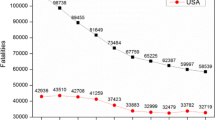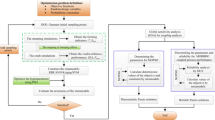Abstract
In the field of automotive safety, the lightweight design of crash absorbers is an important research topic with a direct effect on the occupant safety levels. The design of these absorbers usually requires an optimization of their crashworthiness, which can include multi-objective and reliability-based optimization techniques. This process is very time-consuming, and in spite of the continuous growing of computational power, the problem needs a reliable solving scheme. The use of surrogate models and parallel computing are suitable alternatives to deal with this issue. However, the strongly non-linear response functions obtained from the finite element simulations need careful treatment. This work contributes with the application of a surrogate-based reliability-based design optimization method to an original design of a crash absorber made of metal and a glass-fiber reinforced polymer which is subjected to a frontal impact. Multi-adaptive regression splines models are employed to emulate the original responses, and three different approaches in the sampling stage of the method are compared. The absorbed energy and the mass of the element are considered as objective functions, while the peak value of the force transmitted to the occupants of the vehicle is the design constraint. A discussion of the employed materials is presented and the proposed approaches are compared. Finally, several Pareto fronts are obtained as a solution to the probabilistic problem. Results show that a combination of aluminum and glass fiber reinforced polymer is optimum for this problem, and some design rules are offered.









Similar content being viewed by others
References
ABAQUS 6.13 Documentation (2013) Dassault Systèmes
Abramowicz W, Jones N (1984) Dynamic axial crushing of square tubes. Int J Impact Eng 2(2):179–208
Acar E, Guler MA, Gereker B, Cerit ME, Bayram B (2011) Multi-objective crashworthiness optimization of tapered thin-walled tubes with axisymmetric indentations. Thin-Walled Struct 49(1):94–105
Adams BM, Bauman LE, Bohnhoff WJ, Dalbey KR, Ebeida MS, Eddy JP, Eldred MS, Hough PD, Hu KT, Jakeman JD, Swiler LP, Vigil DM (2013) Dakota, a multilevel parallel object-oriented framework for design optimization, parameter estimation, uncertainty quantification, and sensitivity analysis: Version 5.3.1 user’s manual. Technical report, Sandia Technical Report SAND2010-2183, December 2009. Updated April 2013
Alexander JM (1960) An approximate analysis of the collapse of thin cylindrical shells under axial loading. Q J Mech Appl Math 13(1):10–15
Andrews KRF, England GL, Ghani E (1983) Classification of the axial collapse of cylindrical tubes under quasi-static loading. Int J Mech Sci 25(9-10):687–696
Aoues Y, Chateauneuf A (2009) Benchmark study of numerical methods for reliability-based design optimization. Struct Multidiscip Optim 41(2):277–294
BASF (2012) Ultramid (R) A3WG10 BK00564 Polyamide 66. Product information sheet
Bect J, Ginsbourger D, Li L, Picheny V, Vazquez E (2012) Sequential design of computer experiments for the estimation of a probability of failure. Stat Comput 22:773–793
Bichon B, Mahadevan L, Eldred M (2009) Reliability-based design optimization using efficient global reliability analysis.. In: 50th AIAA/ASME/ASCE/AHS/ASC Structures, Structural Dynamics, and Materials Conference
Cai B, Liu Y, Liu Z, Tian X, Ji R, Li H (2011) Reliability-based load and resistance factor design of composite pressure vessel under external hydrostatic pressure. Compos Struct 93(11):2844–2852
Clausen AH, Børvik T, Hopperstad OS, Benallal A (2004) Flow and fracture characteristics of aluminium alloy AA5083-H116 as function of strain rate, temperature and triaxiality. Mater Sci Eng 364(1-2):260–272
Cook GR, Johnson WH (1983) A constitutive model and data for metals subjected to large strains, high strain rates and high temperatures.. In: Proceedings of Seventh International Symposium on Ballistics
Costas M, Díaz J, Romera LE, Herńandez S, Tielas A (2013) Static and dynamic axial crushing analysis of car frontal impact hybrid absorbers. Int J Impact Eng 62(0):166–181
Costas M, Díaz J, Romera LE, Hernández S (2014) A multi-objective surrogate-based optimization of the crashworthiness of a hybrid impact absorber. Int J Mech Sci 88:46–54
Dubourg V, Sudret B, Bourinet JM (2011) Reliability-based design optimization using kriging surrogates and subset simulation. Struct Multidiscip Optim 44:673–690
European New Car Assessment Programme (Euro NCAP) (2012) Frontal impact testing protocol, version 6.0
Friedman JH (1991) Multivariate adaptive regression splines. Ann Stat 19:1–141
Hasofer AM, Lind NC (1974) Exact and invariant second moment code format. ASCE J Eng Mech Div 100(1):111–121
Holland JH (1975) Adaptation in Natural and Artificial Systems. University of Michigan Press
Hou S, Li Q, Long S, Yang X, Li W (2007) Design optimization of regular hexagonal thin-walled columns with crashworthiness criteria. Finite Elem Anal Des 43(6-7):555–565
Huang M (2002) Vehicle Crash Mechanics. CRC Press
Jansson T, Nilsson L, Redhe M (2003) Using surrogate models and response surfaces in structural optimization - with application to crashworthiness design and sheet metal forming. Struct Multidiscip Optim 25(2):129–140
Kecman D (1983) Bending collapse of rectangular and square section tubes. Int JMech Sci 25(9-10):623–636
Kim IY, De Weck OL (2005) Adaptive weighted-sum method for bi-objective optimization: Pareto front generation. Structural and Multidisciplinary Optimization 29:149–158
Kim IY, De Weck OL (2006) Adaptive weighted sum method for multiobjective optimization: a new method for pareto front generation. Structural and Multidisciplinary Optimization 31:105–116
Liao X, Li Q, Yang X, Zhang W, Li W (2008) Multiobjective optimization for crash safety design of vehicles using stepwise regression model. Struct Multidiscip Optim 35:561–569
Marklund PO, Nilsson L (2001) Optimization of a car body component subjected to side impact. Struct Multidiscip Optim 21(5):383–392
Marler RT, Arora JS (2004) Survey of multi-objective optimization methods for engineering. Struct Multidiscip Optim 26:369–395
Marler RT, Arora JS (2010) The weighted sum method for multi-objective optimization: new insights. Struct Multidiscip Optim 41:853–862
National Crash Analysis Center (2013) Online finite element model archive. http://www.ncac.gwu.edu/vml/models.html.
Paz J, Díaz J, Romera L, Costas M (2014) Crushing analysis and multi-objective crashworthiness optimization of GFRP honeycomb-filled energy absorption devices. Article in press. Finite Elements in Analysis and Design
Picheny V, Ginsbourger D, Roustant O, Haftka RT, Kim N-H (2010) Adaptive designs of experiments for accurate approximation of a target region. J Mech Des Trans ASME 132:0710081–0710089
Picheny V, Kim N-H, Haftka RT (2010b) Application of bootstrap method in conservative estimation of reliability with limited samples. Struct Multidiscip Optim 41:205–217
SAE Standard J211 (1995) Instrumentation for Impact Test.
Salas P, Venkataraman S (2008) Laminate optimization incorporating analysis and model parameter uncertainties for predictable failure. Struct Multidiscip Optim 37(6):541–555
Shin KC, Lee JJ, Kim KH, Song MC, Huh JS (2002) Axial crush and bending collapse of an aluminum/GFRP hybrid square tube and its energy absorption capability. Compos Struct 57(1-4):279–287
Sinha K (2007) Reliability-based multiobjective optimization for automotive crashworthiness and occupant safety. Struct Multidiscip Optim 33:255–268
Stamenović M, Putić S, Zrilić M, Milović LJ, Pavlović-Krstić J (2011) Specific energy absorption capacity of glass-polyester composite tubes under static compressive loading. Metalurgija 50(3):197–200
Starbuck JM, Jacob GC, Dillard DA, Pohlit DJ (2006) Crashworthiness of adhesively bonded composite structures and their strain-rate sensitivities.. In: Proceedings of the 2006 SEM Annual Conference and Exposition on Experimental and Applied Mechanics 2006, vol 4, pp 1808–1819
Tu J, Choi KK, Park YH (1999) A new study on reliability-based design optimization. ASME J Mech Des 121(4):557–564
Vanderplaats Research and Inc. Development (1995) DOT users manual, version 4.20. Technical report
Wahde M (2008) Biologically Inspired Optimization Methods. WIT Press
Yamazaki K, Han J (1998) Maximization of the crushing energy absorption of tubes . Struct Optim 16(1):37–46
Yao W, Chen X, Luo W, Van Tooren M, Guo J (2011) Review of uncertainty-based multidisciplinary design optimization methods for aerospace vehicles. Prog Aerosp Sci 47(6):450–479
Youn BD, Choi KK (2004) Selecting probabilistic approaches for reliability-based design optimization. AIAA J 42(1):124–131
Young YL, Baker JW, Motley MR (2010) Reliability-based design and optimization of adaptive marine structures. Compos Struct 92(2):244–253
Zitzler E, Deb K, Thiele L (2000) Comparison of multiobjevtice evolutionary algorithms: empirical results. Evol Comput 8(2):173–195
Acknowledgments
The research leading to these results has received funding from the Spanish Ministry of Science and Innovation (Ministerio de Ciencia e Innovación) under grant agreement DPI2010-16238 and from the Galician Regional Government (Xunta de Galicia) under the plan GRC2013-056. The authors fully acknowledge the support received. The authors also want to thank Mr. Francisco Javier Bermúdez Cerqueiro for his valuable collaboration.
Author information
Authors and Affiliations
Corresponding author
Rights and permissions
About this article
Cite this article
Cid Montoya, M., Costas, M., Díaz, J. et al. A multi-objective reliability-based optimization of the crashworthiness of a metallic-GFRP impact absorber using hybrid approximations. Struct Multidisc Optim 52, 827–843 (2015). https://doi.org/10.1007/s00158-015-1255-7
Received:
Revised:
Accepted:
Published:
Issue Date:
DOI: https://doi.org/10.1007/s00158-015-1255-7




